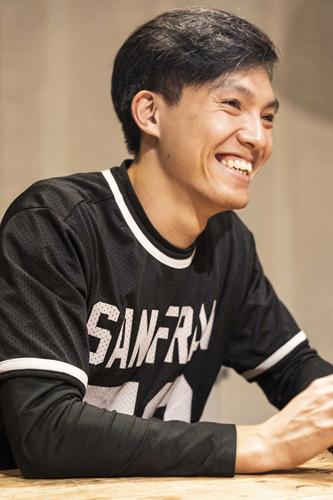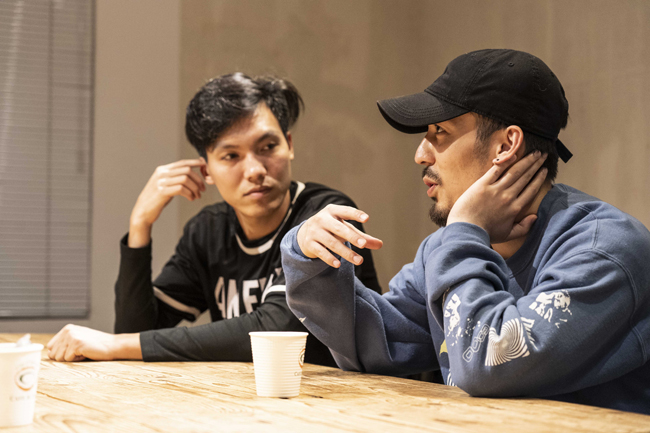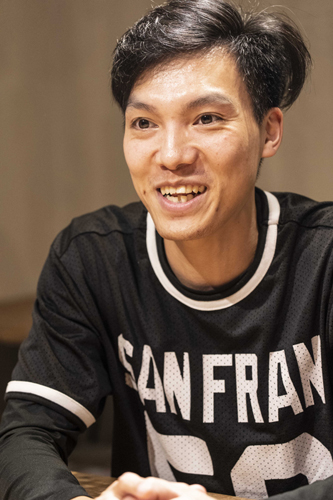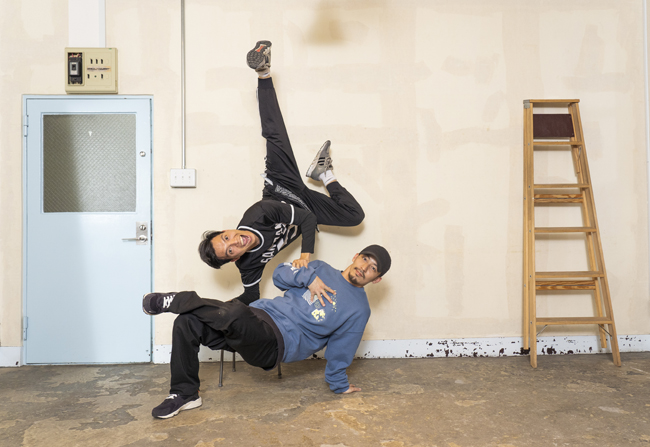The Importance of Connecting This Culture with the Next Generation
Kosugi: How did you decide the theme for this show?
KATSUYA: In terms of the theme, it was absolutely all 3T's ideas.
3T: As a matter of fact, in the first week after arriving in Japan and meeting all the performers, seeing them dance, and talking with them, I actually changed the structure and directing approach I had originally planned. I was originally thinking of using a different kind of music. But after listening to music randomly in my hotel room for about two hours, I found something suitable and then the idea emerged. The inspiration for the performance was seeing Japanese men in suits on the train when I came to Japan in 2015.
There were people sleeping while standing up and everyone seemed just so tired. There's no way I could lead that kind of life, I thought, and I then started doing research on this in my own style and learned how important the role allocated to Japanese men is within the family unit.
This is also the same in Vietnam. "You're a man, so do this," you get told. B-boy culture is freer and more equal, but it's hard to adhere to this kind of attitude in traditional culture. Because normal men have to think about money and the family.
I have put that sort of idea in this show as lots of small tricks. There may be people who empathize with this and those who can't, but it's those people who can't empathize who I want most of all to come and ask why I created the performance. From this we get communication and that's what I want to cherish.
KATSUYA: That's interesting that you could conceive something inspired by what you saw inside a train.
3T: On the train back from the rehearsal studio, it was interesting being able to see various kinds of things. In Vietnam, it's normal to give up your seat to a woman but I was surprised when I did this in Japan and the offer was turned down. An act that is considered friendly in Vietnam can be something that causes astonishment in Japan. I could feel cultural differences in these kinds of things.
KATSUYA: That makes sense. I am really impressed by the choice of themes in your work as well as the way you structure the dance based on that. And this is why I made it my role to strive to support the choreography. As a performance, I thought that there were parts that could be ordered better and so I felt my job was perhaps to look at this objectively and arrange things. Because you can make something incredible from scratch, I want to devote myself to working with you to take that to the next level.
Kosugi: What do you think is important when it comes to shaping a theme?
3T: Ideas. As long as you have an idea, you can turn your theme into movement. In that sense, the team this time brought together superb dancers, which subsequently meant lots of different ideas emerged and I then had to up my game.
It is also important for each of us to understand the ideas. Since we don't all speak the same language, there were times when I couldn't easily get across what I meant. I was uncertain about how to fuse the two cultures of Vietnam and Japan in a way that would elevate this as art. That's when the scene on the train I mentioned before came into my head and led me to incorporate train sounds as one of the motifs. It was all thanks to the fact that I was commuting to rehearsals by train. (Laughs)

Kosugi: What are your thoughts now on the dance scenes in Vietnam and Japan?
3T: Hip hop is a culture that was born about 40 years ago, and there are now lots of different opinions about it from people around the world and many are hoping it will continue to grow.
Originally in Asia, street culture was frowned upon by the general public as a youth culture that people thought was trying to shake things up. But once those youngsters became adults, as they ushered in a new era, the way in which street culture was received and accepted also shifted.
For example, KATSUYA today probably gets asked a lot by people why he is a b-boy. But in 20 years' time, people surely won't ask that kind of question. I think the day will come when a dancer can proudly say "I am a b-boy" to students and acquaintances.
KATSUYA: That's why we have to tell the next generation about the essence of hip hop.
3T: Right. The street culture that is hip hop is constantly evolving. In fact, 20 years ago, no one was dancing hip hop in China. But today there are b-boy competitions and thousands of kids take part. Young parents now send their children to dance schools. The environment in which hip hop exists has really changed so much.

3T: But the essence of hip hop lies always on the inside. We might call it a kind of spirit. I think the most important thing is that in hip hop there is always this idea of showing your true self, what exist inside a person, of showing your pure spirit. In Japan, are there still people who disapprove of hip hop?
KATSUYA: Yes, sometimes. There have been times when I was practicing outside and someone called the police, where to them it just looked like I was playing out on the street at night and had to go home. But I think it is gradually becoming accepted.
You just now mentioned the situation in China and in Japan, too, more and more children are dancing hip hop. Kids are starting to learn dance in exactly the same way that they learn things like swimming. Moreover, breakdancing became an official event at the 2018 Youth Olympics and will be an official event at the 2024 Olympic Games in Paris. That we now have this easily understandable goal of the Olympics means that kids have a dream they can aim for. But as breakdancing gains wider recognition, the fact of the matter is that part of its essence is also lost. A gold medal is a result that is easy to understand but the real essence of hip hop doesn't lie in aiming for that kind of thing.
For me, I think it's important that people involved in hip hop think about the kind of person they want to be, based on an understanding of that essence of hip hop dance―that "hip hop is you." While it's a bit over the top to talk about "dreaming big," it's nonetheless vital that we become that kind of person so that kids can become like the youngsters achieving results at international contests today. I guess it's about getting the balance right.
3T: That's why I think it's important for us to train the young generation and I consider that to be my role. But I'm not doing this because someone is telling me to, but because it's what I want to do.
Kosugi: You spoke just then about dancer training. Can you sense any development among the Asian dancers taking part in DANCE DANCE ASIA?
3T: Well, we stopped arguing! (Laughs) In the past, people used to say that their dance was the best and just bash others. (Laughs) Today we have come to respect other kinds of dance. Not only the hip hop community, we have got to know others and deepen our understanding by talking with different types of dancers. I am also now working across disciplines. Look at older dancers like myself, it seems like the younger generation has become more open to a range of dance styles.

3T: Before, we would spend 90% of our energy on talking and arguing, and then the remaining 10% on dancing, while today it is more like 40% on talking and 60% on dancing. So in the future, perhaps it will be 20% on talking and then 80% on dancing. (Laughs) But for me, talking and discussing is really vital. If everyone is just silent all the time, it's boring, right? I think it's important that we also sometimes have heated discussions. After all, hip hop is all about surviving. (Laughs)
KATSUYA: Right. With Japanese people, though, it's rare for things to become really heated.
3T: But isn't that Japanese culture? We once talked about call-outs, right?
KATSUYA: A call-out is when you call out to and challenge someone you want to battle, whether it's just in the practice studio or backstage at an event when no one else is even watching.
3T: Back when I was young, I used to bristle at others and fight them in call-outs. (Laughs) Now, though, I just dance without the fighting. In the past, I bickered a lot but today if someone gets angry, I just tell him to dance. I've seen how dance partners try to understand one another, whether it's in China, South Korea, or Taiwan, and I think that's the real evolution of hip hop. And we perhaps got to this point thanks to the Internet. Because it now seems like everyone is connected.
Kosugi: KATSUYA, do you see any change among Asian dancers?
KATSUYA: Well, it's still just five years since DANCE DANCE ASIA started. If I'm honest, I don't really feel like there has been any major change. That said, there have been some developments in that not only dancers but now the general public and government have also taken an interest, resulting in opportunities for doing many different things with them, and leading to improvement in dancers' skills and more connections.
What I find really good from watching young dancers in Japan today is how they are increasingly doing what they want to do. For my generation, a large part of what we did was, in a good sense, guided by our elders, and though there are of course still people doing that, youngsters today are thinking about the things they want to do and proactively trying to create their own options.
When there are people like that, it means the reach of breakdancing broadens and this feels somehow typical of hip hop. After all, hip hop is a culture that encompasses these almost nonconformist elements. And that's why I think it could become as big as it has today.
Kosugi: It seems to come down to the question of how we can tell the next generation about the essence of hip hop, including those nonconformist elements. That will surely have a major impact on training in the future. Thank you for speaking with us today.

[On May 16, 2019 at a studio in Tokyo]
Interviewer: Atsushi Kosugi
Writer and editor, Kosugi is mainly involved in covering stage performances and editing brochures. He has been working with DANCE DANCE ASIA since 2016, conducting interviews and editing public relations material such as performance brochures.
Photo: Nobuhiko Hikiji






